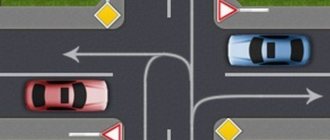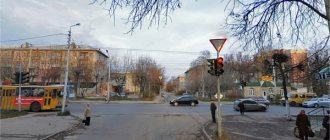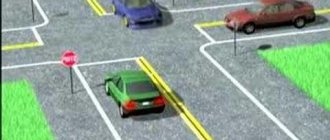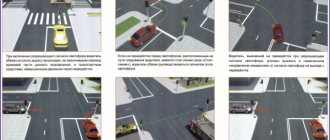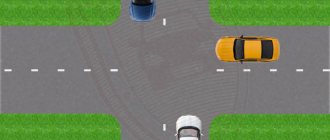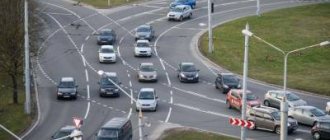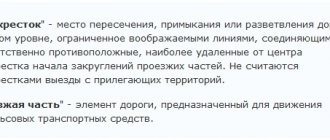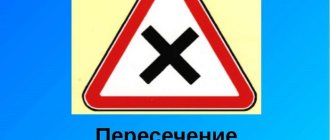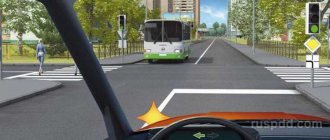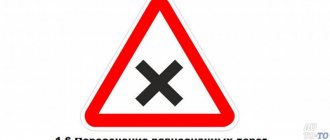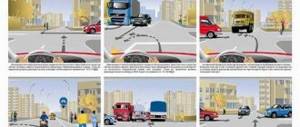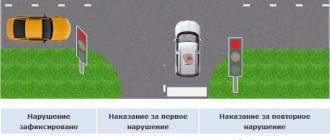An intersection is a place where roads cross, join, or branch at the same level.
In other words, two or more roads, intersecting in one place, form one intersection. Intersections of roads at different levels (overpasses, overpasses, bridges, etc.) are not considered intersections.
Crossroads
Also, exits to the road from adjacent areas do not form intersections.
General rules for driving through intersections
The order of movement through an intersection depends on what type of intersection it is. However, there are general rules that apply at any intersection.
These are the rules:
- When turning right or left at an intersection, the driver is obliged to give way to pedestrians walking across the road on which he is turning, as well as cyclists continuing to move forward along a bicycle path or along the edge of the roadway. The exception is cases when pedestrian traffic is regulated by a separate traffic light. If a prohibitory signal is on for pedestrians while the vehicle is turning, then you should not give way to them.
- It is prohibited to enter an intersection if a traffic jam has formed on it or behind it, which will force the driver to stop at the intersection of roadways, creating an obstacle to the movement of other vehicles in the transverse direction. In this case, you can enter the intersection only in order to immediately leave it in a free direction (for example, by making a turn or U-turn). If you need to move exactly in the direction in which the traffic jam has formed, then you need to stop before entering the intersection of roadways and resume driving only after there is free space for your vehicle beyond the intersection.
- At any intersections, vehicles with blue flashing lights (blue and red) and a special sound signal (siren) on have priority, regardless of the road signs, markings, and traffic lights available at the intersection. Other drivers are required to give way to the special vehicle and those it is accompanying.
Algorithm for driving through intersections
The algorithm for driving through any intersection consists of three actions:
- Firstly, you need to correctly orient yourself and, even before entering the intersection, determine what type it belongs to.
- Secondly, having applied the appropriate rules, you need to give way to those who have the right of way, and then enter the intersection in a timely manner.
- Thirdly, after entering the intersection, you need to leave it in a timely manner in the desired direction. At this stage it may also be necessary to give way to other drivers and pedestrians.
Types of intersections
Intersections can have different configurations. They can be cross-shaped, T-shaped, star-shaped, triangle-shaped, etc.
There are roundabouts and traffic intersections where instead of one large intersection there are several small ones.
However, the rules for driving through intersections do not depend on their shape and size, but on what type of intersection this or that intersection belongs to.
A controlled intersection is an intersection where the traffic order is determined by the signals of an active traffic light or traffic controller.
If there is no traffic light and traffic controller, then the intersection is considered unregulated , and drivers determine the order of passage independently, according to the rules that apply at uncontrolled intersections.
An intersection at which:
- there is a traffic light, but it doesn’t work;
- there is a traffic light, but it operates as a flashing yellow signal;
- the traffic controller is present, but does not give drivers and pedestrians signals to regulate traffic.
It is important to know! In cases where traffic at an intersection is controlled by a traffic controller, drivers and pedestrians must comply with his requirements, even if they contradict traffic lights, priority signs, and other road signs and markings.
Uncontrolled intersections are divided into equivalent and unequal . At an unequal intersection there is always a main road, and the other roads are secondary to it.
Naturally, those on the main road have priority over those on the secondary road.
You must be able to independently find the main and secondary roads at an unequal intersection.
If you fail to do this while approaching the intersection, you will not be able to correctly determine who has the right of way and who must yield. If you do not follow the order of travel, you can cause a serious accident.
Signs of an equivalent intersection
An intersection is equivalent if simultaneously met:
- no traffic lights or traffic controller;
- no priority signs (main road, give way, etc.);
- both intersecting roads have the same surface (hard or dirt).
Additionally, to indicate equivalence, road sign 1.6 “Equivalent intersection” can be used:
Note. The number of lanes and carriageways on roads does not affect the type of intersection.
the main road
Three signs of a main road:
- A motorway marked with sign 5.1 is always the main road in relation to all other roads that adjoin it.
- A hard-surface road (asphalt, concrete, crushed stone, paving stones, etc.) is always the main road in relation to the intersecting or adjacent dirt road, provided that there are no priority signs and sign 1.6 at the intersection.
- A road marked before the intersection with priority signs 2.1, and outside populated areas also with signs 2.3.1-2.3.7 (2.3.1, 2.3.2, 2.3.3, 2.3.4, 2.3.6, 2.3.5, 2.3. 7, is always the main road in relation to the intersection or adjacent road. The road, which is marked with signs 2.4 or 2.5, is always secondary. Signs 2.1, 2.4 and 2.5 are installed immediately before the intersection, and 2.3.1 - 2.3.7 at a distance of 150 - 300 meters away.
At some intersections the main road may turn left or right. In this case, priority signs are installed with signs 8.13 “Direction of the main road”: sign 2.1 - with sign 8.13, and signs 2.4 or 2.5 - with sign 8.13.
The main road is shown on these signs as a thick line, and the secondary roads are shown as thin lines. If signs 2.1, 2.4 or 2.5 are installed without signs 8.13, then you can be sure that neither the main nor the secondary road at this intersection changes direction.
If the driver cannot determine the presence of surface on the road (darkness, mud, snow, etc.), and there are no priority signs at the intersection, then for safety reasons he should assume that he is on a secondary road.
It is important to know! Priority signs are also installed at signalized intersections, but in this case drivers must obey not them, but exclusively the signals of the traffic light or traffic controller. If the traffic light fails or is turned off, the intersection will become uncontrolled, and only then the established priority signs will come into force. Thus, approaching an intersection, the driver should first of all pay attention to the presence of a traffic light (traffic controller), and only if there is none, look for priority signs in the field of view.
At an equivalent intersection there are no main and secondary roads - all intersecting roads are equal in importance. As a rule, there is no heavy traffic at such intersections, so there is no point in installing traffic lights and priority signs.
Their absence is a sign of an equivalent intersection. In some cases, but not always, a warning sign 1.6 may be installed in front of an equivalent intersection.
Equivalent intersections have their own rules of passage, which differ from the rules in force at controlled and unequal intersections.
First in the circle
The relevant government regulations were published this week. Now those who drive in a circle have an advantage over those who drive out into it. What's new here, some amazed readers will ask. After all, this is how it has been until now. But no.
Until now there has been, and until next Wednesday, the following rule: if there is a “give way” sign under the “roundabout” sign, then the main road is on the roundabout, and everyone who is about to enter it must give way. If there is no “give way” sign under the “roundabout” sign, then the one who is just entering the circle has priority. After all, for someone driving in a circle, he is a hindrance on the right.
Such a number of travel variations often baffled drivers. As a result, some chose the “I give in to everyone” tactic, and some went ahead. The result is an accident.
Infographics "RG": Leonid Kuleshov/Vladimir Barshev/b>
Therefore, it was decided that the rules for driving through such intersections should not have options, and the circle was made the main one by definition.
That is, starting from Wednesday, if there are no additional signs hanging under the “roundabout” sign, then the one who is just about to enter the roundabout must give way. Those driving in a circle should not give way to anyone, except for cars with special signals on.
Let us remember that before all these experiments with circular motion, the circle was of secondary importance. As a result, all the adjacent streets stood still because there was a circle.
Infographics "RG": Leonid Kuleshov / Vladimir Barshev
However, it is still possible to establish traffic management depending on road capacity. That is, on a circle, the main road can still be distinguished by especially separate signs. For example, a major road with a large traffic load passes through a roundabout, and roads of lesser importance are adjacent to it. At such intersections, of course, priority signs will be installed indicating who is more important at this intersection.
Infographics "RG": Leonid Kuleshov / Vladimir Barshev
The second government decree published this week concerns the introduction of new “crossroads section” markings. In common parlance it was called a “waffle iron.” These are yellow cross lines that are painted directly at the intersection. You can't stop there. It will be considered that you entered the intersection when there was a traffic jam and created problems for those moving across you. And for this you face a fine of 1000 rubles. And photo and video recording cameras regularly carry them out at intersections where until now this marking has been used as an experiment. Such intersections will be indicated by the sign 1.35. But no one knows what it will look like yet. It should be developed by the Ministry of Transport and Rosstandart. Therefore, the amendment will come into force only in six months. Mass use of waffle markings is not planned. Moreover, the conditions for its application require changing the operating modes of traffic lights. You cannot run counter threads at the same time. After all, those who need to turn left will be required to stop at this marking in order to let oncoming people pass. This means that the travel time at such intersections will increase significantly.
Driving through unregulated intersections
The rules establish the order of passage through an uncontrolled intersection depending on the type of intersection, the relative position of vehicles or pedestrians, as well as the directions of their further movement.
At the same time, some road users must give way to others.
However, if you know for sure that your path at the intersection will not intersect with the path of another vehicle (for example, when moving towards each other in the forward direction), then with such a vehicle you can move through the intersection at the same time.
Driving through unregulated intersections of equivalent roads
At an equivalent intersection, all roads adjacent to it are equal in importance. However, this does not mean that all participants in the movement are in equal conditions.
At such an intersection there are two queues: the first is for trams, and the second is for trackless vehicles.
When at an equivalent intersection there are several trams and trackless vehicles whose paths intersect, within each of these two queues drivers are guided when entering the intersection by the well-known rule of obstacles on the right, according to which such an obstacle must be given way.
According to this rule, trams pass each other, and trackless vehicles pass each other, after the trams have passed.
By giving way to trams and trackless vehicles on your right, you gain the right to enter an equivalent intersection.
However, in some cases it is not possible to leave it immediately.
Before you go in the right direction, you must:
- when turning right, give way to pedestrians and cyclists who cross the road to your right;
- when turning left - give way to oncoming vehicles moving straight and to the right (that is, in the same direction you want to turn), as well as to pedestrians crossing the road to your left;
- when turning - to oncoming vehicles and those approaching the intersection from the left side (in the process of turning, such vehicles will also become oncoming traffic);
- when driving straight, you can leave the intersection without hindrance if you entered it correctly earlier;
- turning left of two vehicles moving from opposite directions can be performed simultaneously, provided that both drivers choose non-intersecting trajectories and maintain a safe lateral interval. In this case, driving at the intersection is carried out on the right side. When making such a pass, you need to be careful, since an oncoming vehicle turning left may block a car or motorcycle traveling in the forward direction.
Equivalent intersections are characterized by low traffic intensity, so a situation where trackless vehicles approached simultaneously from four sides and interfered with each other on the right occurs very rarely.
The rules do not regulate such a situation, therefore, drivers will have to determine the order of movement by agreement. After one of the four vehicles passes first, the remaining three drivers will be able to pass each other according to the rule of interference on the right.
Traffic rules: driving through uncontrolled intersections
13.9.
At the intersection of the main and secondary roads, vehicles moving on the secondary road must stop and give way to cars traveling on the main road.
13.10.
If a primary road changes direction, motorists traveling along the primary route must use equivalent road intersection rules.
13.11.
If two equal roads intersect, the driver of the car must give way to vehicles moving on the right. The same applies to rail transport drivers.
Clause 13.11 of the traffic rules for crossing intersections 2021 has an exception: if there is a roundabout at an intersection, the motorist must give way to cars moving along this intersection.
13.12.
If it is necessary to turn left, the driver of the car must give way to other cars heading along the same path from the opposite direction/to the right.
13.13.
If a driver moves through an intersection at night and cannot determine what kind of surface is on the road and does not observe any priority signs, he should assume that he is driving on a secondary road.
Driving through unregulated intersections of main and secondary roads
If there is a main road at an uncontrolled intersection, vehicles moving along it have priority over those moving along a secondary road.
In this case, it does not matter which road your vehicle will be on after passing through the intersection - the order of movement is determined by which road you approached it on.
Thus, a driver turning from a main road onto a secondary road still has priority over a driver turning from a secondary road onto a main road.
It is important to know! In any case, a driver on a secondary road is not allowed to enter the intersection until the main road is clear of all vehicles that are either already at the intersection or approaching it.
If there is tram traffic on the main or secondary road, entry to the intersection is carried out in four queues:
- the first priority is made up of trams arriving along the main road;
- the second stage consists of trackless vehicles arriving along the main road;
- the third line consists of trams arriving along a secondary road;
- The fourth line consists of trackless vehicles that arrived on a secondary road.
Thus, your turn at such an intersection may be second or fourth, depending on which road you approached.
If the main road turns at an intersection, then it is possible that the trajectories of vehicles on the main road intersect with each other.
The same situation is possible between vehicles located on secondary roads.
In this case, drivers who find themselves in equal conditions, that is, on roads of equal importance, must be guided among themselves by the rule of interference on the right.
Drivers on secondary roads disperse, guided by this rule, after both directions of the main road are completely cleared.
Leaving an unequal intersection is carried out according to the same rules as leaving an intersection of equivalent roads. When turning left or right, you must give way to pedestrians and cyclists.
If the main road does not turn, then when turning left and making a U-turn you will have to give way to oncoming vehicles. At intersections where the main road turns, exiting to the left is not difficult, and the turn should be made as shown in the figure.
Order of movement
Driving through equivalent intersections is regulated by two points of the traffic rules (13.11 and 13.12), the first of which applies to all maneuvers at the intersection, and the second - only to turning left and making a U-turn:
13.11. At the intersection of equivalent roads, with the exception of the case provided for in paragraph 13.111 of the Rules, the driver of a trackless vehicle is obliged to give way to vehicles approaching from the right. Tram drivers should follow the same rule among themselves.
13.12. When turning left or making a U-turn, the driver of a trackless vehicle is obliged to give way to vehicles moving on an equivalent road from the opposite direction straight or to the right. Tram drivers should follow the same rule among themselves.
Right turn
When making a right turn, the trajectory of the white car does not intersect with the trajectories of other cars, so this maneuver can be performed regardless of whether vehicles are approaching from other directions.
Go straight
When driving straight, the trajectory of the white car intersects with the trajectories of other cars. In this case, you should give way to an orange car that is approaching the intersection on the right.
Turn left or make a U-turn
Let me remind you that when making a left turn or a U-turn at an equivalent intersection, in addition to paragraph 13.11 of the rules, paragraph 13.12 also applies. Therefore, it is necessary to give way to both cars approaching from the right (regardless of which direction they are traveling) and to cars that are coming towards you and making a right turn or continuing to drive straight. Those. You should give way to both the orange and blue cars.
Please note that the trajectory of your car will not always intersect with the trajectories of the vehicles listed above, so not all cars need to give way.
For example, if multi-lane roads intersect at an intersection, then cars will be able to pass each other and their trajectories will not intersect.
Driving through controlled intersections
At controlled intersections, the order of movement is determined by signals from the traffic light or traffic controller. If the traffic controller’s signals contradict the traffic light signals and the instructions of the road signs, then you must be guided by the traffic controller’s requirements.
If traffic light signals contradict the requirements of road signs 2.1, 2.4 or 2.5, then you must be guided by the traffic light.
The permitting signal from a traffic light or a traffic controller allows you to enter a controlled intersection. Permissive traffic light signals are:
| Green light | Green light with green additional arrow | Red or yellow light with green additional arrow |
| Allows entry to the intersection. | Allows entry to the intersection and movement in all directions. | Allows entry to the intersection only for traffic in the direction indicated by the arrow. |
It is important to know! When driving on a prohibitory (red or yellow) signal with a green additional arrow, the driver must give way to any vehicles moving from other directions.
When there is a prohibiting signal from a traffic light or a traffic controller, the driver must stop in front of the stop line indicated by markings or sign 6.16, and in their absence, in front of the roadway being crossed, without interfering with pedestrians.
Leaving a controlled intersection
Exiting a controlled intersection is determined by the direction of your further movement. Trams pass each other, and trackless vehicles pass each other according to the following rules:
- a driver moving straight does not give way to anyone;
- the driver of a tram or trackless vehicle turning right gives way only to pedestrians and cyclists who continue moving straight;
- a driver turning left gives way to oncoming vehicles (including those making a right turn), as well as to pedestrians continuing to move straight;
- The driver making a U-turn gives way only to oncoming vehicles.
Driver actions when changing traffic lights
Having entered an intersection at a permissive traffic light (including a flashing green one), the driver must clear the intersection, even if the traffic light has switched to a prohibitory signal, provided that there are no stop lines on his route through the intersection.
However, if there is a stop line after the prohibiting signal has turned on, the driver is obliged to stop in front of it and resume driving only after the light turns green again.
The same rule should be followed at an intersection with a traffic controller.
Taking into account the above, at busy intersections, if necessary, turn left or turn around at a green light, the following sequence of actions is recommended:
| STEP 1 | STEP 2 | STEP 3 |
| The driver enters the intersection following the traffic light signal, stops in the middle of the intersection, and gives way to oncoming vehicles. | The driver waits for the green signal to switch to yellow and makes sure that the oncoming car has slowed down to stop. | The driver turns left behind the last oncoming car, despite the traffic light. |
It is important to know! Even after the traffic light turns on, the driver must give way to vehicles completing their movement through the intersection, as well as to pedestrians completing the crossing of the road.
Basic rules for driving through an intersection with a traffic light
A controlled intersection is one where traffic is controlled by a traffic light or a traffic controller. It is worth noting that driving through areas with such regulation is much easier than using priority signs, because it is not always clear which of them are intended for drivers in the oncoming and adjacent lanes.
Thus, the green signal of the device, which is permissive, allows you to pass through the intersection, regardless of what priority signs are placed on it. Another thing is that the priority is regulated by the direction of movement of the vehicle, because it is one thing if it goes straight and to the right, and quite another thing when it is necessary to make a left turn or turn around.
Right
By turning right on the main green signal, the driver gains priority over all other cars moving in the opposite or adjacent direction.
The only road users who will have to give way when performing such a maneuver are pedestrians crossing the adjacent zebra crossing.
See also:
When is a fine possible when crossing the rightmost continuous line on the road?
Left or U-turn
Things are a little more complicated if a motorist driving towards the permitting signal of the main (round) section of the road control device needs to turn left or turn around right at the intersection, although even here there is a simple algorithm, mastering which will help you not get lost in the future. According to it, a motorist performing any of the mentioned maneuvers must yield:
- anyone moving straight in the opposite direction;
- to everyone who turns left while driving in oncoming traffic;
- pedestrians crossing the road in the adjacent lane after making a maneuver.
As for the oncoming passing of vehicles turning left, it is carried out in two ways: without crossing each other’s path with their right sides or with crossing the conventional path of movement with their left sides. You have to choose the optimal of these two methods on the spot, based on the configuration of the intersection and the behavior of other drivers.
In this case, it is recommended to drive to the center line of the intersection, let all oncoming traffic pass and complete your maneuver. You cannot act in this way if a sufficient number of cars have already accumulated in the center of the intersection, otherwise you can create a traffic jam.
It will be possible to turn around in such a place only if there is no sign next to the permitting signals prohibiting such a maneuver. In addition, a sign with a crossed out left turn is interpreted as permission to change the direction of travel.
If the prohibitory light comes on, the car that has managed to enter the intersection must complete the maneuver, making sure that those whose green light is already on are allowing it to pass.
Directly
Driving directly to the main traffic light signal gives the vehicle driver complete privilege. This means that he will not have to let oncoming cars or cars driving in the adjacent lane pass, as well as pedestrians, for whom the prohibiting signal should automatically light up.
An exception may be sections of roads with unregulated pedestrian zones, because in this case those who walk along the zebra crossing will have a privilege.
Traffic rules with traffic lights and priority signs
It is important to remember that traffic priority signs, which always back up traffic lights in case they break down or are turned off at night when traffic is lighter, will only have priority in the latter two situations. Simply put, you only need to follow the signs when the optical signaling device is not working.
Also, the green light automatically eliminates the concept of a main and secondary road, as well as an obstacle on the right, especially since changing lanes at an intersection is only allowed if there is a traffic jam or an accident ahead, and it is possible to get around them.
See also:
Instructions from the regulator: what could be the consequences if not followed?
